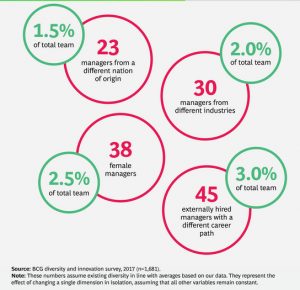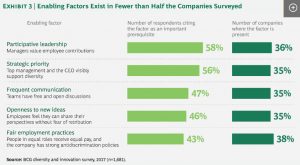“Hire a chief innovation officer.” “Change the culture.” “Look outside your industry.” There’s no shortage of advice about how companies can become more innovative. The catch is that most of that advice is based on anecdotal evidence. But there’s one step companies can take that does have some data behind it.
A recent BCG study suggests that increasing the diversity of leadership teams leads to more and better innovation and improved financial performance. In both developing and developed economies, companies with above-average diversity on their leadership teams report a greater payoff from innovation and higher EBIT margins. Even more persuasive, companies can start generating gains with relatively small changes in the makeup of their senior teams.
For company leaders, this is a clear path to creating a more innovative organization. People with different backgrounds and experiences often see the same problem in different ways and come up with different solutions, increasing the odds that one of those solutions will be a hit. In a fast-changing business environment, such responsiveness leaves companies better positioned to adapt. (See “Diversity at Work,” BCG article, July 2017.) This argument has always made intuitive sense, and now we have some convincing correlations to add to the case.
Diversity Gaining Momentum Worldwide
We surveyed employees at more than 1,700 companies in eight countries (Austria, Brazil, China, France, Germany, India, Switzerland, and the US) across a variety of industries and company sizes. (This was a followup study to one we reported on last year in The Mix That Matters: Innovation Through Diversity, BCG Focus, April 2017, and discussed in an accompanying TED talk.) We looked at perceptions of diversity at the management level across six dimensions—gender, age, nation of origin (meaning employees born in a country other than the one in which the company is headquartered), career path, industry background, and education (meaning employees’ focus of study in college or graduate school). To gauge a company’s level of innovation, we looked at the percentage of total revenue from new products and services launched over the past three years.
Broadly, 75% of respondents said that diversity is gaining momentum in their organizations. Employees at companies in emerging markets (China, Brazil, and India) reported greater progress over the past several years than companies in developed markets. The biggest takeaway we found is a strong and statistically significant correlation between the diversity of management teams and overall innovation. Companies that reported above-average diversity on their management teams also reported innovation revenue that was 19 percentage points higher than that of companies with below-average leadership diversity—45% of total revenue versus just 26%
. (See Exhibit 1.) In other words, nearly half the revenue of companies with more diverse leadership comes from products and services launched in the past three years. In an increasingly dynamic business environment, that kind of turbocharged innovation means that these companies are better able to quickly adapt to changes in customer demand. Not surprisingly, these organizations also reported better overall financial performance: EBIT margins that were 9 percentage points higher than those of companies with below-average diversity on their management teams.
More: www.bcg.com
Authors: Rocío Lorenzo, Partner & Managing Director, Munich; Nicole Voigt, Partner & Managing Director, Düsseldorf; Miki Tsusaka, Senior Partner & Managing Director, Chief Marketing Officer, Tokyo; Matt Krentz, Senior Partner & Managing Director, Chicago

